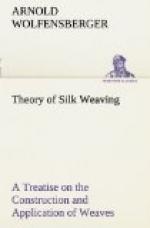The making out of the Drawing-in Draft, which
must indicate the arrangement or the rotation in which
the warp-threads are drawn in, can be done in various
ways, of which we will mention the two most popular
methods. The first is by using common designing
paper, and indicating the rotation by dots. The
horizonal rows of squares represent the shafts, the
vertical rows the warp-threads. Fig. 1 shows four
repeats of a straight draw on six harness marked out
according to this idea. A second method is to
use paper ruled horizontally, the lines representing
the shafts; and to draw vertical lines for the warp-threads.
The latter are made to stop on
[Page
9]
the lines bearing the number of the shafts into which
the respective threads are to be drawn. Fig.
2 is such a draft, illustrating six repeats of a draw
on four harness from “Front to Rear.”
* * * * *
SKIP DRAWS
[Illustration: Fig. 3]
* * * *
[Illustration: Fig. 4]
The draws coming under this heading are used very extensively in silk weaving, especially for fabrics requiring a heavy warp and a large number of shafts. Enter first the odd and then the even shafts. An 8 harness draw of this kind, of which three repeats are shown in Fig. 3, runs as follows: 1, 3, 5, 7, 2, 4, 6, 8.
Fig. 4 is a 12 harness draw of the same class.
* * * * *
POINT DRAWS
[Illustration: Fig. 5]
* * * *
[Page 10] [Illustration: Fig. 6]
* * * *
[Illustration: Fig. 7]
* * * *
[Illustration: Fig. 8]
* * * *
[Illustration: Fig. 9]
[Page 11] Point draws are a combination of a regular straight draw from back to front and one from front to back, the first and the last shafts only being used once, while the rest receive two ends each in one repeat of the draw. Fig. 5 illustrates a regular point draw in 2 repeats on 10 shafts. It will be seen that 14 ends make a repeat; in fact, the number of warp-threads required for one draw will always be double the number of harness less 2, hence a 12 harness regular point draw will require 22 warp-threads for a repeat.
The drawing-in draft illustrated in Fig. 6 is a slight variation of the regular point draw; it consists, as will be seen, of a draw from back to front, and also a full one from front to back, there by causing a double point.
Another change from the regular point draw is illustrated in Figs. 7 and 8; this class may be called Broken point draws, because a new draw is begun before the other one is complete. Fig. 9 also comes in this class and represents a zigzag draw on 10 harness.




